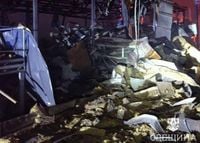In the early hours of November 4, 2025, the skies over Ukraine erupted in a cacophony of explosions and sirens as Russian forces unleashed a large-scale overnight assault, according to Ukraine’s Air Force. The attack, which spanned several regions of the country, featured a barrage of missiles and a swarm of explosive drones, marking one of the most intense bombardments in recent weeks.
According to Caliber.Az, citing Ukrainian media sources, the offensive began with the launch of an Iskander-M ballistic missile from Russia’s Rostov region. This was followed by six S-300 surface-to-air missiles, fired from the Kursk region, and a staggering 130 attack drones. Among these unmanned aerial vehicles were Iranian-designed Shahed drones—an increasingly familiar and ominous presence in Ukrainian airspace—alongside other models.
Ukraine’s air defenses sprang into action, and their efforts were nothing short of heroic. The Air Force reported that 92 of the attacking drones were intercepted or neutralized as they streaked across the northern, southern, and eastern regions of the country. Despite these defensive successes, the volume and persistence of the attack meant that not every threat could be stopped. In total, missile and drone strikes struck 14 locations, with confirmed impacts from six missiles and 31 drones.
While the Ukrainian military worked to repel the aerial onslaught, a more sinister incident unfolded on the ground just a day earlier. On November 3, in the village of Kruhliakivka in the Kharkiv region, Russian forces carried out a drone strike targeting civilians. According to ArmyInform, the victims were moving along a road under a white flag—a universally recognized symbol of non-combatant status—when they were struck. The attack killed two unarmed people and a dog.
The communications unit of Ukraine’s 77th Separate Air Assault Brigade, which reported the incident, released footage that appears to show the targeted strike on these civilians. The brigade emphasized that there were no military positions or facilities anywhere nearby, underscoring the non-combatant status of the victims. In a chilling twist, the Russian troops reportedly filmed the strike themselves, intending to use the footage in propaganda materials to falsely blame the Ukrainian Armed Forces. The brigade described this as a “false-flag operation,” part of a wider campaign of disinformation designed to obscure Russia’s violations of international law.
“There were no military positions or facilities nearby,” the brigade stated, highlighting the apparent intent behind the attack. The ArmyInform report added, “The attack is part of Russia’s ongoing disinformation campaign to hide its violations of international law.”
This incident is not an isolated case. The same report from ArmyInform described another recent atrocity: a Russian soldier opening fire inside an apartment building in the temporarily occupied Kharkiv region, resulting in the deaths of three civilians. An intercepted call revealed that the soldier had “lost control,” a phrase that does little to mask the brutality of the act.
These events, taken together, paint a grim picture of the evolving nature of Russia’s military campaign in Ukraine. The use of drones—both for large-scale attacks on infrastructure and for targeted strikes on civilians—reflects a shift in tactics that has placed ordinary Ukrainians in ever greater peril. The fact that some of these drones are Iranian-designed Shahed models has drawn international attention, raising questions about the extent of foreign support for Russia’s drone program and the broader implications for regional security.
For Ukraine, the toll is both immediate and deeply personal. Each missile and drone that slips past air defenses threatens not just military targets, but homes, schools, and the fragile sense of normalcy that Ukrainians cling to amid the chaos. The attack on Kruhliakivka, with its deliberate targeting of civilians under a white flag, strikes at the heart of the laws of war and the basic principles of humanity.
Analysts note that the use of false-flag operations and disinformation campaigns is a hallmark of modern hybrid warfare. By filming the attack and seeking to blame Ukrainian forces, Russian troops are not only violating international humanitarian law, but also attempting to manipulate the narrative and sow confusion both domestically and abroad. These tactics, while not new, have become increasingly sophisticated as the conflict drags on, with both sides vying for control over the story as much as the territory.
Ukrainian officials have repeatedly called on the international community to recognize and respond to these violations. The evidence of deliberate attacks on civilians, combined with the documented use of disinformation, has fueled demands for increased sanctions and support. For many in Ukraine, these appeals are not just about justice—they are a matter of survival.
The psychological impact of such attacks cannot be overstated. For residents of Kharkiv and other targeted regions, the knowledge that civilian convoys and even apartment buildings can become targets adds a layer of fear and uncertainty to daily life. The use of drones, which can appear with little warning and strike with precision, has only heightened this sense of vulnerability.
Meanwhile, Ukraine’s air defense crews continue their relentless work, often under the cover of darkness and with limited resources. Their success in intercepting 92 out of 130 drones during the November 4 assault is a testament to both their skill and their determination. Yet, as the numbers show, the sheer volume of attacks means that some threats inevitably get through, with devastating consequences.
International observers have condemned the attacks, particularly those targeting civilians and employing false-flag tactics. Human rights organizations have called for thorough investigations and accountability for those responsible, warning that such actions could constitute war crimes under international law.
As the conflict grinds on, the people of Ukraine find themselves caught in a deadly game of cat and mouse, where technology, propaganda, and sheer willpower collide. Each new attack is a reminder of the stakes—and of the resilience required to endure.
In the aftermath of these latest strikes, Ukrainian leaders have renewed their calls for advanced air defense systems and greater international solidarity. For now, the country’s defenders remain vigilant, knowing that each night could bring another wave, another test of their resolve, and another chapter in a conflict that shows no sign of ending soon.




